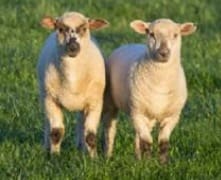
More Kiwi lambs were produced from fewer ewes in 2017.
A RECORD New Zealand lambing percentage has underpinned a lift in lamb numbers and offset a declining ewe flock, according to Beef + Lamb New Zealand’s Lamb Crop 2017 report.
Research by B+LNZ’s Economic Service estimated the number of lambs tailed in spring 2017 was 23.7 million head, up 1.9 percent (436,000 head) on the previous spring.
The average ewe lambing percentage for 2017 was 127.2, up 4.4pc on last year and up 6.4pc on the 10-year average (2008-09 to 2017-18) of 120.8pc.
Overall, this meant 127 lambs were born per hundred ewes compared with an average of 121 over the last 10 years. For spring 2017, a 1pc change in the New Zealand ewe lambing percentage is equivalent to 178,000 lambs.
The number of lambs available for export processing in 2017-18 at 19.27 million head is similar to last season’s 19.25 million head (+0.1pc).
The tonnage of lamb produced is expected to decrease slightly (-0.2pc) due to a lower average carcase weight, which offsets an increase in total number processed.
More lambs from hoggets
B+LNZ’s Economic Service chief economist Andrew Burtt, said the record lambing percentage and more lambs from hoggets offset fewer breeding ewes.
“The report provides further evidence of sheep and beef farmers doing more with less.”
North Island lamb numbers were a major factor behind the overall lift in the New Zealand lamb crop with growth of 4.9pc (551,000 head) to 11.7 million head.
In the North Island, the average ewe lambing percentage for 2017 was 128pc, up 8.6pc on last year.
“This was a record high, and was due to good climatic conditions and ewe condition at both mating and lambing for most regions.
“However, after autumn and winter conditions were generally good, but wet, lamb growth rates were lower than normal due to a lack of sunshine, cool damp weather and more lambs,” Mr Burtt said.
“This has had a negative impact on lamb growth.
“On a positive note, there were no adverse weather events during lambing.”
In the East Coast and Taranaki-Manawatu, bearings and subsequent losses negatively impacted the lambing result.
Breeding ewes declined 1.9pc
According to the survey, the number of breeding ewes declined 1.9pc to 17.8 million at July 1 2017.
“The most significant decrease was in Taranaki-Manawatu (-3.6pc) in response to strong mutton prices and culling of old ewes to take advantage of strong prices,” Mr Burtt said.
In the South Island, lamb numbers decreased 1pc (115,000 head) to 12.0 million head.
The decrease was influenced by Southland, where fewer ewes were mated, the lambing percentage was slightly lower than the previous year and there were fewer lambs from hoggets.
In the South Island, the average ewe lambing percentage for 2017 was 126.4pc, up 0.3pc on 2016. This was due to an overall lift in lambing percentage for most regions except Southland, Mr Burtt said.
“This season’s lambing was characterised by mostly good climatic conditions, with isolated weather events causing losses in parts of the high country, and wet, stormy snaps of weather in north Marlborough and Southland.”
Lamb survival was below average in north Canterbury and Marlborough, but better than last year in Otago and Southland.
B+LNZ Economic Service’s Lamb Crop survey is drawn from its Sheep and Beef Farm Survey, which covers a statistically representative sample of over 500 commercial sheep and beef farms.
Read the Lamp Crop 2017 report here.
Source: B+LNZ.



HAVE YOUR SAY